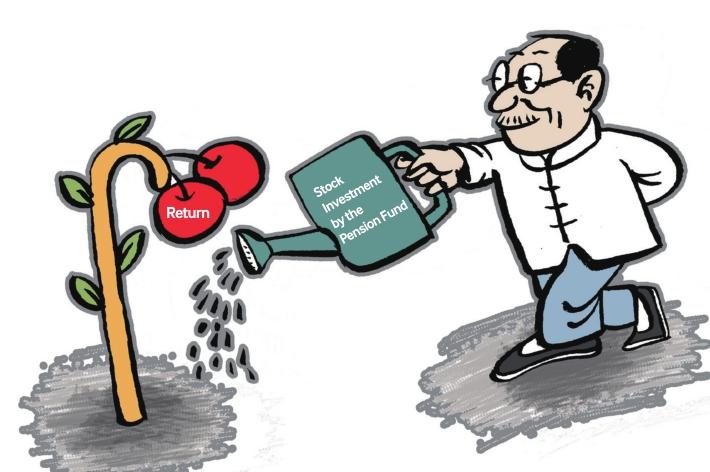A Stronger Safety Net
2019-05-21ByLiXiaoyang
By Li Xiaoyang
As Chinas population ages and the workforce shrinks, there will be a greater demand for funds to finance more social security benefits. It is estimated that by 2025, the number of people aged 60 and above will reach 300 million. By 2050, the money spent on elderly care-related services and facilities will account for 26.24 percent of the GDP, according to a blue paper on the health of seniors released by the Chinese Aging Well Association and Social Sciences Academic Press (China) in January. In 2015, the fi gure was 7.33 percent.
Faced with the need for more funds, the National Social Security Fund (NSSF), the reserve fund established in 2000 to supplement and adjust social security spending such as pension benefits during the peak of population aging, has stepped up judicious investments in recent years and maintained a stable performance.
The NSSF, with more than 2.22 trillion yuan ($331 billion) in assets at the end of 2017, gets its money from allocations by the Central Government, the transfer of state-owned capital, investment pro- ceeds and capital raised by other methods approved by the State Council, Chinas cabinet.
It is a heavyweight institutional investor in Chinas primary A-share market, in addition to investing in bonds and other financial instruments. It has been at the center of industrial attention for the funds investment options, returns and standards for choosing private equities, especially after it successfully weathered several bear markets and seized the opportunities to buy the dips—purchasing shares after their prices drop.
According to Wang Zhongmin, former Vice Chairman of the National Council for Social Security Fund (SSF), which manages the NSSF, the funds investment returns had snowballed to over 1 trillion yuan ($149 billion) by 2018, representing about 40 percent of total managed assets.
Putting eggs in many baskets
Traditionally, social security funds in China were deposited with banks or used to purchase treasury bills. However, their an- nual yields ran the risk of falling below the market average and depreciating due to infl ation. To transform idle funds into more reserves, the NSSF expanded investment in a variety of fi nancial products, including stocks and trust loans, by combining direct and mandated investment. The targets range from finance companies to enterprises focusing on green development.
In pursuit of long-term returns, the NSSFs investments are prudently made to avoid risks. The fund mainly invests in shares of large companies for steady gains, especially those in the banking, pharmaceutical, chemical, electronics and food industries. Except for 2008, when the global financial crisis erupted, the fund has generated considerable returns every year. The average annual investment yield since its inception in 2000 has been 8.44 percent.
The investments are made either by the SSF or are entrusted to external managers. As the fund manages more assets, the proportion of its entrusted investment—investments made through external managers—has also grown, along with the returns. By the end of 2017, the funds direct investments had exceeded 941 billion yuan ($140 billion). Mandated investment also reached about 1.2 trillion yuan ($179 billion), according to offi cial data.
The NSSF has directly invested in some financial institutions and leading enterprises in hi-tech materials and new energy sectors. Private equities are also rising to a key target of the direct investment.
In 2015, the NSSF made its fi rst investment in an innovation-oriented private enterprise. The recipient was Ant Financial, an affiliate of e-commerce giant Alibaba.“This indicates that it actually favors new business models and has a keen interest in participating in the development of such startups to share the growth,” Wang said.
This investment has become one of the funds largest sources of profi t, according to Wang. The estimated value of Ant Financial was $30 billion when the fund invested in it. The fi gure has now skyrocketed to $160 billion. Wang said the boom in Internet finance will increase the value of Internet-based fi nancial institutions and contribute more to the fund if it invests in them.
Today, the NSSF has become the largest limited partner in the country. Still there is a huge potential for growth. In 2017, the NSSFs investments in private equities represented only 2 percent of the assets it managed, far below the governmentimposed cap of 10 percent.
Venturing into stocks
On April 4, the State Council announced that employers contributions to urban workers basic pension insurance would be reduced from 20 to 16 percent starting on May 1. The new policy will cut pension insurance contributions by more than 190 billion yuan ($28.3 billion) by the end of 2019, You Jun, Vice Minister of Human Resources and Social Security, said at a news conference.
While it is good news for enterprises that are feeling the downward pressure on the domestic economy, there are also concerns that it could lead to a reduction in the pen- sion fund as the costs of senior care rise. Off icial data showed the elderly population in China reached over 249 million in 2018, 17.9 percent of the population.
Chinas social security system consists of five mandatory schemes—pension fund, basic medical insurance, work injury insurance, unemployment insurance and maternity insurance. Both employers and employees are required to contribute to the pension fund.
“Market-oriented and diversifi ed investment of the pension fund will increase its gains… and promote social entrepreneurship,” Jin Weigang, head of research with the Ministry of Human Resources and Social Security, said.
A recent report by the Chinese Academy of Social Sciences forecasts that the state pension fund is likely to reach its ceiling by 2027 and run dry by 2035 due to the shrinking workforce.
To address the disparities between income and spending, national unified management of the pension insurance scheme is needed, Zhao Yaohui, a professor at the National School of Development, Peking University, said.
As a step in that direction, this year, the government will support more provinces and cities to entrust the NSSF with managing their pension funds.
The Central Government has formulated a series of measures, including increasing the transfer of state-owned capital to the NSSF, to ensure full and on-time payment of the pension, said Nie Mingjun, an official with the Ministry of Human Resources and Social Security (MOHRSS), on April 23.
In some regions, pension funds have been allowed to invest in the stock market. Mandated investment of pension funds of 17 provinces, autonomous regions and municipalities reached 858 billion yuan($128 billion) by the end of 2018. However, the gains are still inadequate to fi ll the gap caused by social security fee reductions, Lu Aihong, a spokesperson for the MOHRSS, told a press conference.
